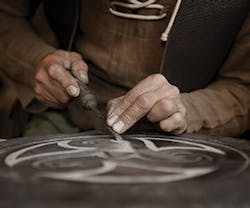Not long ago, I came across some research that confirmed what I suspected for years: Taking notes by hand leads to better information comprehension and retention than using a laptop. Apparently, using pen and paper requires your brain to be more selective about what to process; in other words, you think more.
Experts say that creative writing is also more successful when done by hand, because the unfinished state and slower pace of a longhand draft is more likely to be reconsidered and refined than the misleading finished appearance of a typewritten draft. This logic also applies to hand sketching and model building. There is something humbling and meditative about wielding pencils, Exacto knives, and straightedges that is lost when tapping and scrolling in front of a computer screen.
It is no coincidence, then, that we’re living in a time of renewed appreciation for craftsmanship. The same thing occurred at the turn of the 20th century in Britain, when the Arts and Crafts movement began as a backlash to industrialism. Today we seem to crave handmade, one-of-a-kind, imperfect products with charm that cannot be recreated by mass production. Just as the Slow Food movement began in opposition to the unhealthy fast food culture, artisanal products take us back to their makers, introduce us to a specific time and place, and feed our collective desire for something personal and authentic.
Several years ago at Dwell on Design, I discovered some beautiful pendant lights by Graypants called Scraplights, which are made of corrugated cardboard. Inspired by the significant amount of discarded cardboard boxes they found in dumpsters and alleys, designers Seth Grizzle and Jonathan Junker created a hugely successful lighting line out of their Seattle studio. They continue to use mostly recycled materials in their products as they’ve branched out to furniture and package design.
Operating out of a workshop in Red Hook, Brooklyn, Uhuru builds furniture such as pieces fashioned from weathered Ipe wood from the Coney Island boardwalk or an enormous 300-year-old antique pine timber. Together, the provenance of the materials and the craftsmanship of the construction resonate strongly with its users in a way that machine-made products cannot replicate.
I recently had the privilege of representing the American Society of Interior Designers (ASID) on a tour arranged by the Brazilian Association of Interior Designers. In some of the finest furniture showrooms in São Paulo, Brazil, I saw firsthand the sensuous, sculptural benches of Hugo Franca, shaped from the burned out logs from the Bahia jungle; the incredible handstitched leather of lounge chairs by Sergio Rodrigues and Jader Almeida; and the mind-blowing joinery showcased in a sideboard by Isay Weinfeld. The tradition of Brazilian wood craftsmanship was ineffably unforgettable.
In April I visited a farm-to-table restaurant in Cape Town, South Africa, that features a ceiling festooned with “roses” created from used milk bottles and artwork crafted from tiny, twisted strips of old newspapers. Discarded bleach jugs and soda bottles had been transformed into pendant lights and wall-hung planters. The handcrafted décor, like the cuisine, was ingenious and ineffably linked to a time and place.
I adore my smartphone apps and love the pristine precision of my German car. However, I am increasingly finding myself craving a more personal connection with the objects I own, especially as I’m downsizing and trying to shed all extraneous items to leave only the ones that mean the most to me. I’ve been thinking about how we constantly interact with materials of all kinds and react in specific ways to those materials and items. As design professionals, we have the power to balance the assortment of materials and items in a space, and ensure that the reactions they elicit are positive, personal, inspirational, and memorable.
Charrisse Johnston, ASID, LEED AP BD+C, Associate AIA, is the Chair of the Board of Directors and a principal and the firm-wide interior design practice leader at Steinberg Architects. Learn more about ASID at ASID.org.
